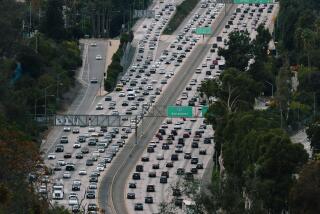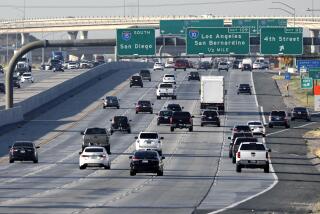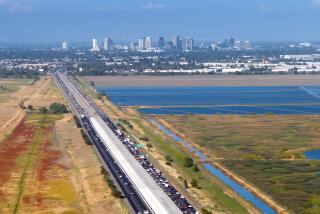Caltrans’ goal: Speed up crash cleanups
- Share via
When those pesky SigAlerts and fender-benders occurred on California’s freeways in 2006, it took emergency crews an average of three hours and six minutes to completely clear the roadway, while angry commuters fumed in cars that were often backed up for miles.
Caltrans Director Will Kempton said at a conference Tuesday in Riverside that the state was committed to slicing in half the average for clearing accidents.
“We’re setting the bar very high,” Kempton said. “Last year our average clearing time per accident was 3.1 hours, and that’s down from 5.6 hours in 2003. That’s a 45% improvement.”
Kempton said the objective was to be able to clear all incidents in 90 minutes. “We need a commitment from transportation and public safety agencies statewide in order to improve coordinated action between all these different responders,” he said.
To that end, a wide-ranging group of firefighters, police officers, traffic analysts, emergency medical personnel, freight operators and tow-truck drivers from across the state gathered at the Riverside Convention Center on Tuesday for a two-day conference aimed at smoothing communications and brainstorming about how to clear accidents more quickly.
About a quarter of the congestion on U.S. roadways is due to traffic incidents, Kempton said, and on California’s most problematic roadways, such as Interstate 880 in the Bay Area, accidents can contribute to as much as a third of congestion.
But traffic analysts with the California Department of Transportation acknowledged that they were just beginning to set up the cameras and other monitoring systems that will pinpoint the specific sources of gridlock on the state’s busiest corridors, particularly in Southern California and the Bay Area.
Despite the heavy traffic flow in San Bernardino and Riverside counties, the average clearance time last year beat the state average by a few minutes, according to a preliminary Caltrans study.
It took about 20 minutes longer than the 3.1-hour state average to clear incidents in the Los Angeles-Ventura county region, and five to seven minutes longer in the Orange County and San Diego-Imperial county regions, the study showed.
Some of the causes of the delays include misunderstandings about which agency should call the coroner after fatal accidents, and officers giving inaccurate information to tow-truck operators about what equipment was needed to clear the roadway, officials said.
“Ninety minutes is the least we can do for the public,” CHP Commissioner Mike Brown said.
A chief challenge will be reducing accident-clearing delays at a time when there is a record $10.8 billion of road construction underway in California, Kempton said.
Last month, the California Transportation Commission allocated $4.5 billion in projects from the $19.9-billion transportation bond measure approved by voters in November. About $2.7 billion of the bond money has been earmarked for projects in the Southland.
*
More to Read
Sign up for Essential California
The most important California stories and recommendations in your inbox every morning.
You may occasionally receive promotional content from the Los Angeles Times.











